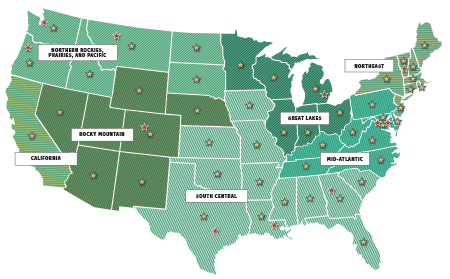The National Wildlife Federation is a leader in the effort to keep invasive carp out of the Great Lakes.
First imported into the United States in the 1960s and 1970s for use in southern aquaculture facilities and retention ponds, species like bighead and silver carp escaped during flooding and have wrecked the fisheries of the Mississippi River watershed where they have taken over. As filter feeders, they consume the base of the aquatic food chain, starving out and outcompeting native fish species. Additionally, silver carp become a safety hazard to boaters and anglers on waters they inhabit, leaping feet out of the air and weighing up to 40 pounds.
Recent studies have predicted that they could thrive in Lake Michigan and Lake Erie if they become established, where they could spread to connected inland rivers and lakes, as well, jeopardizing the Great Lakes $7 billion annual sport-fishing economy and the freshwater ecosystems of the Great Lakes region.
The National Wildlife Federation works to keep invasive carp out of the Great Lakes by:
In recent years, successful projects have closed pathways in Minnesota and Indiana. The closure of the St. Anthony Falls Lock and Dam in Minnesota closed a connection between the Mississippi River watershed and the Great Lakes watershed, and the construction of the Eagle Marsh berm in Indiana closed a connection point between the Maumee River—which flows into Lake Erie—and the Wabash River. However, work on one of the most critical locations for keeping invasive carp out of Lake Michigan is stalled on the release of a draft plan outlining options for improving defenses at the Brandon Road Lock and Dam near Joliet, Illinois. This location below the confluence of the Des Plaines and Illinois Rivers could prevent Asian carp from advancing further into the Chicago Area Waterways System, which connects to Lake Michigan at multiple points.
Though a series of electric barriers are operated within the system to deter the transfer of invasive species between the watersheds, in 2009 invasive carp eDNA (biological traces of the existence of a species) was found on the Lake Michigan side of the barriers and the U.S. Fish & Wildlife Service confirmed in 2015 that juvenile invasive carp can be pulled through the barriers by passing barges.
The U.S. Army Corps of Engineers identified Brandon Road Lock and Dam as a critical chokepoint in its 2014 report on options to stop invasive carp, and they were authorized by Congress in 2015 to begin a study on improving defenses at that location. The Asian Carp Regional Coordinating Committee—made up of governmental agencies from the Great Lakes region—prioritized Brandon Road Lock and Dam in its 2015 and 2016 action plans, and the US Army Corps of Engineers’ draft plan outlining options was expected to be released in February 2017, but unexpectedly delayed by the Trump administration.
Our current priority is advocating for the release of the draft study on options for the Brandon Road Lock and Dam, because until that study is released, work cannot move forward. The invasive carp aren’t waiting on the study, and neither can we.
Fact Sheet: Invasive Carp in the Great Lakes
Timeline: Invasive Carp in the U.S.
Take the Clean Earth Challenge and help make the planet a happier, healthier place.
Learn MoreA groundbreaking bipartisan bill aims to address the looming wildlife crisis before it's too late, while creating sorely needed jobs.
Read MoreMore than one-third of U.S. fish and wildlife species are at risk of extinction in the coming decades. We're on the ground in seven regions across the country, collaborating with 52 state and territory affiliates to reverse the crisis and ensure wildlife thrive.
